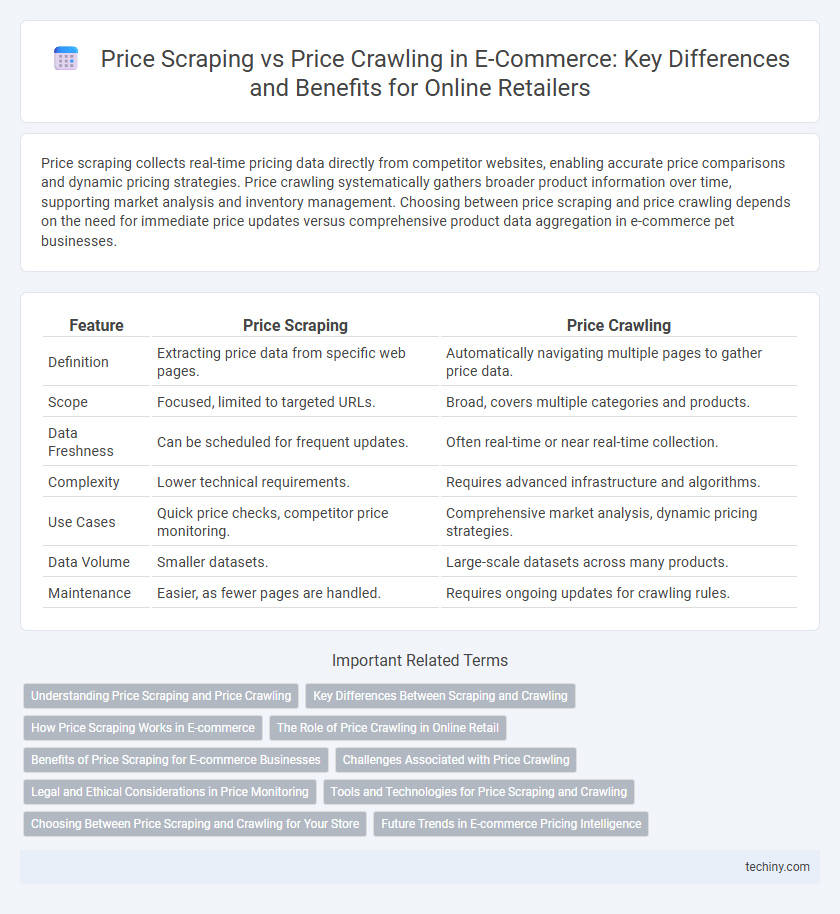Price scraping collects real-time pricing data directly from competitor websites, enabling accurate price comparisons and dynamic pricing strategies. Price crawling systematically gathers broader product information over time, supporting market analysis and inventory management. Choosing between price scraping and price crawling depends on the need for immediate price updates versus comprehensive product data aggregation in e-commerce pet businesses.
Table of Comparison
| Feature | Price Scraping | Price Crawling |
|---|---|---|
| Definition | Extracting price data from specific web pages. | Automatically navigating multiple pages to gather price data. |
| Scope | Focused, limited to targeted URLs. | Broad, covers multiple categories and products. |
| Data Freshness | Can be scheduled for frequent updates. | Often real-time or near real-time collection. |
| Complexity | Lower technical requirements. | Requires advanced infrastructure and algorithms. |
| Use Cases | Quick price checks, competitor price monitoring. | Comprehensive market analysis, dynamic pricing strategies. |
| Data Volume | Smaller datasets. | Large-scale datasets across many products. |
| Maintenance | Easier, as fewer pages are handled. | Requires ongoing updates for crawling rules. |
Understanding Price Scraping and Price Crawling
Price scraping in e-commerce involves extracting specific pricing data from competitor websites to monitor market trends or adjust pricing strategies in real time. Price crawling automates the process of systematically browsing multiple web pages to collect comprehensive pricing information, often encompassing product details and stock availability. Understanding the distinction improves competitive analysis and ensures efficient data collection tailored to business needs.
Key Differences Between Scraping and Crawling
Price scraping involves extracting specific pricing data from targeted webpages to monitor competitors' prices, whereas price crawling systematically navigates through entire websites or multiple sites to gather broad pricing information. Scraping focuses on the accuracy and precision of exact price points, while crawling emphasizes comprehensive data collection over a large scale. These key differences influence the choice of tools and techniques used in e-commerce price intelligence strategies.
How Price Scraping Works in E-commerce
Price scraping in e-commerce involves extracting pricing information directly from competitors' websites using automated tools that target specific HTML elements containing price data. This process enables businesses to collect real-time pricing updates, product availability, and promotional offers without manual input, supporting dynamic pricing strategies. By continuously gathering and analyzing competitor prices, retailers can optimize their pricing models to remain competitive and boost profit margins.
The Role of Price Crawling in Online Retail
Price crawling in online retail involves automated tools systematically collecting extensive pricing data from competitors' websites to map market trends and adjust strategies in real-time. This process enables retailers to optimize pricing dynamically, enhance competitive positioning, and improve profit margins by responding swiftly to market fluctuations. Leveraging price crawling technologies empowers e-commerce businesses to maintain pricing intelligence, driving informed decisions that attract price-sensitive customers and increase sales conversion rates.
Benefits of Price Scraping for E-commerce Businesses
Price scraping enables e-commerce businesses to gather real-time competitor pricing data, allowing for dynamic price adjustments that enhance market competitiveness. By extracting structured pricing information from multiple sources, businesses can optimize profit margins and tailor promotions effectively. This technique reduces manual effort, accelerates decision-making, and supports data-driven pricing strategies critical in the fast-paced online retail environment.
Challenges Associated with Price Crawling
Price crawling in e-commerce presents challenges such as high server load leading to potential IP blocking and data inaccuracies due to dynamic website content. Managing the legal and ethical considerations of scraping competitive pricing data adds complexity to maintaining compliance. Ensuring real-time accuracy while navigating complex site structures and anti-bot measures demands advanced technical solutions and continuous monitoring.
Legal and Ethical Considerations in Price Monitoring
Price scraping and price crawling in e-commerce must navigate complex legal frameworks including data protection laws and intellectual property rights, ensuring compliance to avoid litigation. Ethical considerations emphasize transparency, avoiding deceptive practices that harm competitors or consumers, and respecting website terms of service. Businesses should implement policies that balance competitive intelligence with responsible data usage to maintain trust and uphold market fairness.
Tools and Technologies for Price Scraping and Crawling
Price scraping tools like Octoparse, Scrapy, and ParseHub specialize in extracting specific pricing data from product pages using customized XPath selectors or CSS queries, enabling precise and efficient retrieval of competitor prices. Price crawling technologies leverage automated web crawlers such as Selenium and Puppeteer to navigate dynamic websites, handling JavaScript content and multiple product listings to gather comprehensive pricing information across e-commerce platforms. Machine learning algorithms and proxy integration further enhance the effectiveness of scraping and crawling tools by improving data accuracy and bypassing anti-scraping measures deployed by online retailers.
Choosing Between Price Scraping and Crawling for Your Store
Price scraping extracts specific pricing data from competitor websites in real-time, enabling dynamic pricing strategies and competitive analysis. Price crawling involves systematically navigating through multiple pages to gather extensive product and price information, ideal for comprehensive market research and inventory monitoring. Selecting between the two depends on your store's need for granular, up-to-date pricing details versus broader data coverage for long-term strategy planning.
Future Trends in E-commerce Pricing Intelligence
Price scraping and price crawling are evolving with artificial intelligence and machine learning, enabling more precise real-time pricing intelligence in e-commerce. Advanced algorithms process vast datasets to detect competitor pricing strategies, optimize dynamic pricing models, and predict market trends. The integration of automated price monitoring tools is accelerating the shift toward highly personalized pricing strategies and enhanced competitive analysis.
Price Scraping vs Price Crawling Infographic

 techiny.com
techiny.com